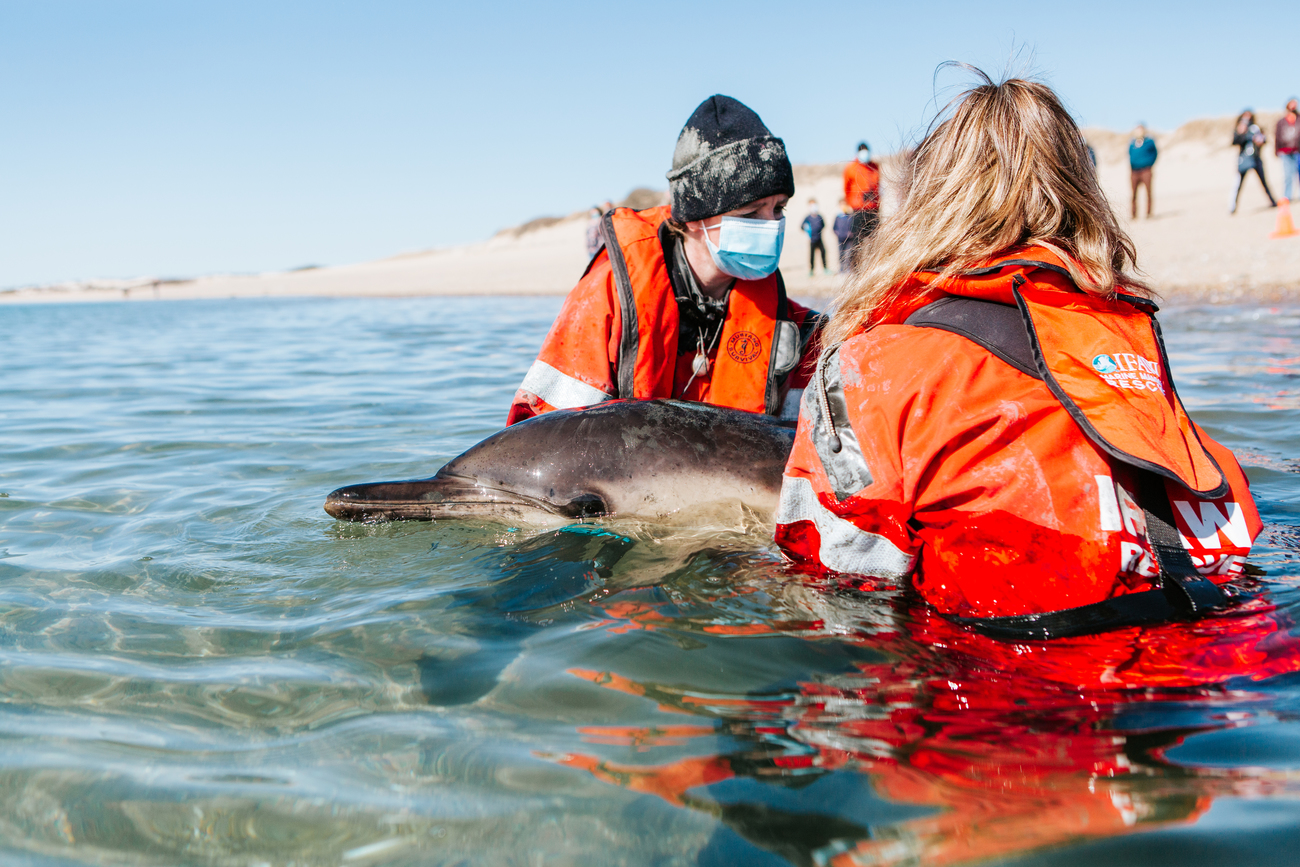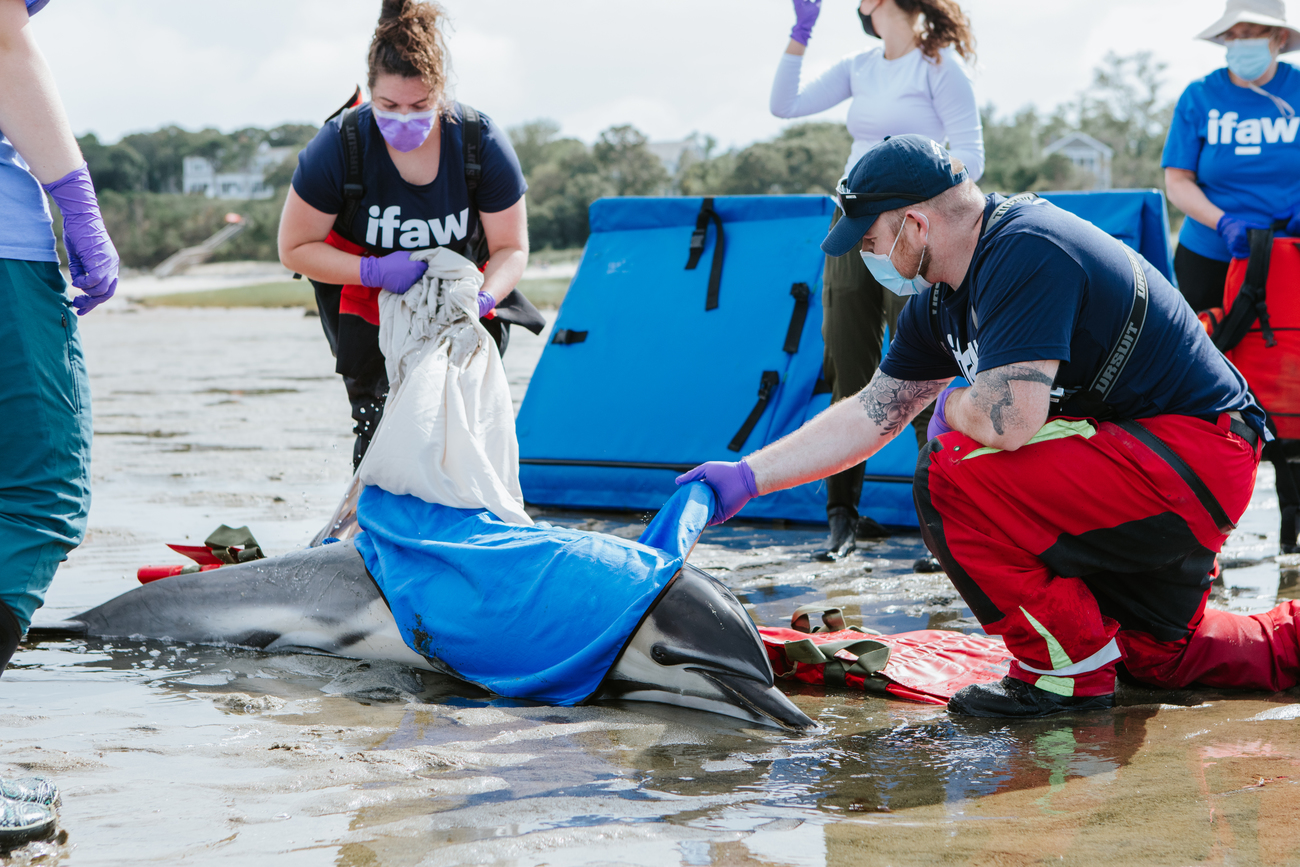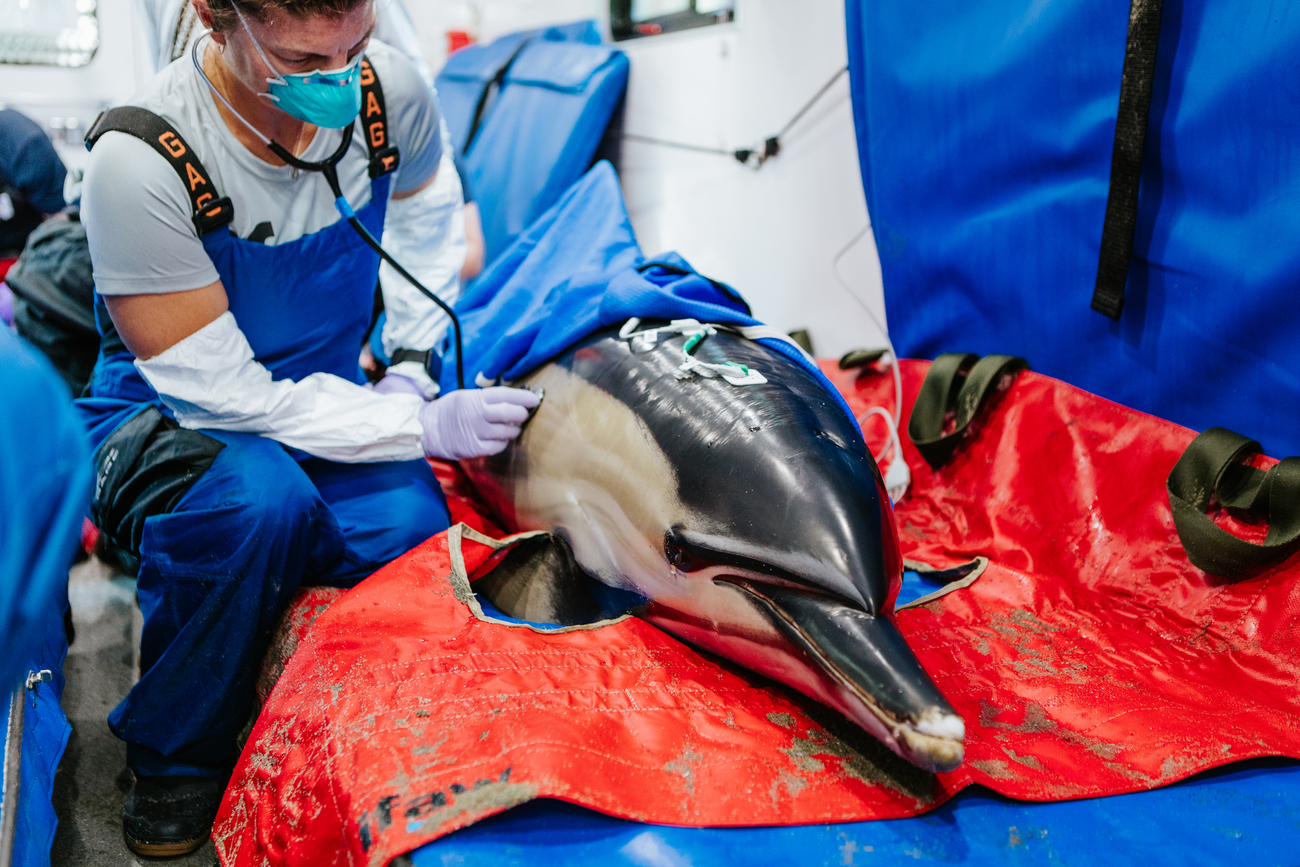Stranded Marine Mammal Rescue - Global
When the tide is low, the stakes are high for marine mammalsfaq: what to do if you see a stranded dolphin
faq: what to do if you see a stranded dolphin

The 700-mile (1130 km) stretch along the shores of Cape Cod is a global hotspot for cetacean (dolphin and whale) strandings. Here, live dolphins strand more frequently than anywhere else in the world. IFAW has been the first line of defense for stranded marine mammals in distress for the past 20+ years, rescuing and releasing them, whenever possible, back into the wild. While seeing a stranded dolphin can be distressing, most well-intentioned actions can do more harm than good. Continue reading to learn more about what to do if you find dolphins swimming too close to shore or already stranded.
If you have found a live or dead marine mammal (whale, dolphin, porpoise or seal) on Cape Cod or in southeastern Massachusetts, please call IFAW’s stranding hotline.
508-743-9548
For stranded animals outside of IFAW’s response area:
what should I do if I find a stranded dolphin?
Stay a safe distance away (150 feet, 45 meters, or four school bus lengths), keep your pets leashed, and call your local stranding response organization to speak with a marine mammal responder. Stranded dolphins are often in need of medical attention by trained responders before they can be released back into the ocean. Notifying our team immediately helps us get to the animals faster, and it gives the animals their best chance of survival!
why do dolphins strand?
There can be many reasons why a dolphin might strand including...
- Natural occurrence: Strandings have been historically documented and occur all over the world. Cape Cod, where our IFAW marine mammal rescue team is located, is a known hotspot for live dolphin strandings, particularly mass strandings.
- Landmass shape: Cape Cod is shaped like a hook jutting out into the Atlantic and encircling Cape Cod Bay, which can make navigating back to open ocean difficult.
- Tidal fluctuations: Some areas of Cape Cod experience nearly 13 feet of tidal change. This, combined with large areas of shallow sand flats, can cause dolphins to become trapped when the tide falls.
- Social structure: Some cetacean species have strong social bonds and groups will stick together even if one individual becomes sick or injured.
- Injured or sick: Sick or injured dolphins may become separated from the group, be too weak to swim against currents or become disoriented and unable to navigate.
- Weather: Extreme winds and weather could push animals closer to shore than they normally travel.
- Human impacts: Entanglements in fishing gear, vessel strikes, acoustic disturbances caused by undersea noise, or other human activities could cause dolphins to strand.
is it ok for a dolphin to be out of water?
Dolphins are marine mammals that have lungs and breathe air, just like us. While they do live their life entirely in an aquatic environment, a stranded dolphin can survive for many hours out of water with proper supportive care by trained responders.

should I move a stranded dolphin back into the water?
Definitely not. Stranded dolphins have experienced trauma similar to a car accident and likely need medical care and treatment before they can be released back into the ocean. When an animal is pushed back it will often restrand in a different location where it might not be reported and cannot receive care, or it can restrand deceased. In addition, dolphins are quite heavy and require specialized stretchers to safely move them and prevent damage to their tail stock, fins and flippers–which have bones that can be dislocated causing the dolphin to be unable to swim.
should I pour water on a stranded dolphin or cover it?
No. Approaching a stranded dolphin can be stressful for the animal and dangerous for humans and animals alike. Only trained responders should approach, touch, or provide care to prevent further stress or injury to the animal.
why aren’t dolphins immediately released back into the ocean where they are found?
Often, the location where dolphins strand is shallow and subject to large tidal fluctuations. Based on decades of experience, we know that treatment, along with transport to a location with quick access to deep, open ocean offers the best chance of survival for stranded dolphins.
what kind of care do the dolphins receive when they are rescued?
Once the dolphins are rescued by our trained responders, they are moved into a one-of-a-kind mobile dolphin rescue vehicle that was custom designed to meet the needs of what is considered a global stranding hotspot on Cape Cod. The vehicle enables IFAW veterinarians and experts to perform health assessments and stabilize the dolphins with IV fluids and other treatments to help counteract the shock the dolphins experience from the stranding, all while quickly reaching the best site for release.
are the dolphins tracked after release?
Some are! Temporary satellite tags are vital tools that allow us to monitor animals after they are released. Tag data provides information back to our experts, such as swim speed, which can give indications of how well the animal is faring. They can also monitor whether they are returning to habitat that is appropriate for their species. More broadly, they tell us if the animal has survived or stranded again. Learn more facts about satellite tagging dolphins and whales.

are you able to save every stranded dolphin?
While we are constantly advancing our response protocols to reflect the best available science, we occasionally have animals that do not survive. Our experienced veterinarians assess each animal individually to determine if they are healthy enough for immediate release. Unfortunately, in some cases, humane euthanasia is the best course of action to prevent further suffering. A necropsy (animal autopsy) is often performed so we can learn as much as possible about why they may have stranded in the first place, and how we can better help the next ones that strand on our shores.
Coming soon! Some dolphins require short-term rehabilitation prior to release back to the wild to treat conditions caused by a stranding event, such as muscle injury and shock. While this was previously not possible, our exciting new initiative, the Cetacean Intensive Care Unit, will finally enable us to provide much-needed veterinary care to these animals over the course of a few days. In the ICU, dolphins will receive expanded treatments guided by advanced diagnostics to get them healthy enough to be released, allowing us to save even more lives.
Related content
every problem has a solution, every solution needs support.
The problems we face are urgent, complicated, and resistant to change. Real solutions demand creativity, hard work, and involvement from people like you.